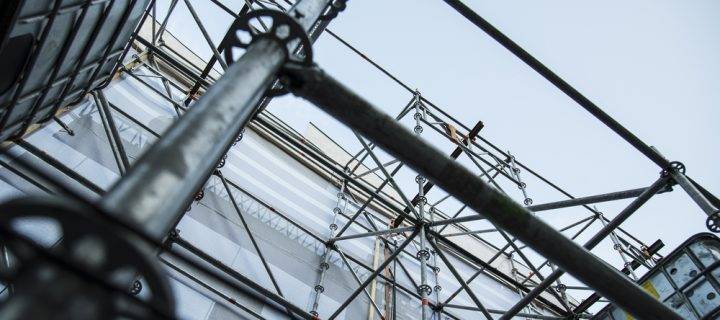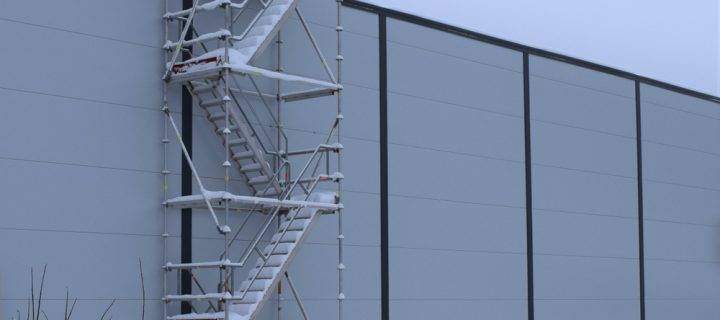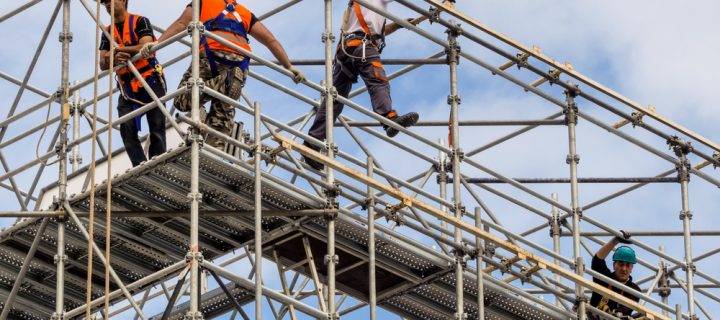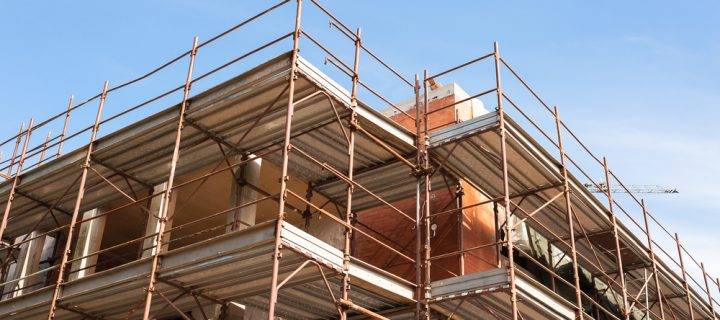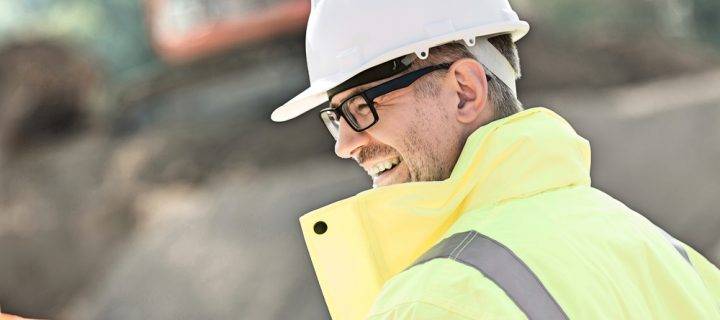If you’ve never used scaffolding for a construction project before, you may not know all the components that are required. Network Scaffold are seasoned experts in erecting and dismantling scaffolding on projects right across Derbyshire, Tamworth and the surrounding areas. Every Component of Scaffolding Explained Here we are going to explain all of the components required to make your scaffolding safe and secure – Putlogs and Transoms – Putlogs and transoms should be horizontal and securely fixed to ledgers or standards with right-angled or putlog couplers. They will need to be supported with the flattened end placed right into the mortar bed joint of brickwork with putlogs approximately 75mm long. Ledgers – Ledgers should be horizontal and securely fixed to inside of standards with right-angled load-bearing couplers. They also need to be fitted in such a way that joints are staggered between bays. Ledger Bracing – Ledgers need to be fitted on alternative pairs of standards except where the width of the bays are 1.5mm or less, which means they should be fitted on every third pair. They should be fitted with ledgers or standards using load-bearing fittings, to the full height of the scaffold and start at the base level. Standards – Standards should be fitted vertically or inclined slightly towards the structure and spaced in such a way as to give sufficient support. They should also be on a base plate, or on a base plate and sole board to prevent displacement and near to ledgers. Finally, standards need to be fitted so any joints are staggered between bays. Longitudinal or Facade Bracing – These should be fitted to all scaffolds that do not get the longitudinal stability by any other means. Bracing needs to be connected to every lift of extended transoms with right-angled couplers or to every standard with swivel couplers. All joints should be manufactured with sleeve couplers. Ties – Ties link the scaffold to the structure and help to resist inward and outward movement plus they give additional longitudinal stability. Scaffold Boards – The minimum a scaffold board can overhang a putlog or transom is 50mm, with the maximum overhang dependant on the thickness of the board. Decking – Decking and working platforms...
Read Moreabout Understanding Basic Components for ScaffoldingTemperatures have dropped considerably over the past few weeks, with winter definitely on the way it’s important to know how to safely use scaffolding in colder conditions. Network Scaffold are experienced providers of scaffolding in Staffordshire and Derbyshire, with our structures hired for both domestic and commercial projects. Potential falling snow and ice plus low temperatures are just a handful of the issues construction workers face on the job every day. Making sure your site is safe with routine checks and procedures when unpredictable weather hits is a must for site managers. In our latest blog, we are going to share some essential tips for scaffold safety. Seven Ways to Prevent Injuries On-Site 1. Follow Maintenance Procedure – Before mounting scaffold, inspect it to ensure the boards are sound and nothing is visibly damaged. If the weather is stormy or windy do not work on scaffolds outside, as this is one of the most common causes of accidents. If employees continue to work in rain, sleet or snow, they will be putting their lives at risk as the boards can become slippery and lead to slips and falls. 2. Train Your Employees – As the Site Manager, it’s your job to keep your staff trained, as scaffolding or any other site equipment shouldn’t be used without sufficient training. 3. Worksite Inspection – Days on-site should begin with an inspection to make sure all snow and ice have been eliminated from surfaces where employees are working or passing through. Continuous inspections should also take place during the day to ensure that no ice has built upon the scaffold. Remove icicles that pose a safety hazard or tape off areas underneath them if they cannot be removed. Next, check all heaters and train employees on safely using heaters and generators and keep combustible materials away from the heaters. The complete structure of the scaffold will be built to withstand the weight of snow and ice, but this may not always be the case during stages of the construction. If you have received sudden or heavy snowfall, check that that partial structure can withstand the extra weight of the snow without posing any threat to workers. 4. Proper Weather Wear – Frostbite...
Read Moreabout Safety Tips for Scaffolding in WinterAs a considerate employer and scaffold provider Network Scaffold, always ensure all of our staff are supported through any mental health issues. In our latest blog, we are going to discuss a new initiative from the National Access and Scaffolding Confederation to support scaffolders. World Mental Health Day supports Scaffolders The National Access and Scaffolding Confederation recently announced, as part of World Mental Health Day on 10th October 2019, that they will be offering free guidance and advice on mental health. The aim of this campaign is to reduce the stigma surrounding mental health and raising awareness of the different support services available to workers in the scaffolding industry. This has been one of the key objectives of the NASC’s Head for Heights campaign, which started last year. One of the key achievements of the campaign to date has been the production of SG38:19, dedicated health and wellbeing policy guidance. This document is designed to help employers adopt a clear approach to provision and includes resources, advice and contact details of other organisations who can provide support. Another resource from the NASC is the mental health toolbox talk, which has been circulated to over 300 members and is a short presentation that instructs employers how to start conversations with their employees about their mental health. Safe and Secure Scaffolding from Network Scaffold Here at Network Scaffold, we understand the disciplines of health and safety, are integral to providing the best scaffolding for your project. If you’d like to know more about our health and safety procedures, please read our Health & Safety Policy. Want to Work with a Leading Scaffolding Provider? Get in Touch! We regularly work on a mix of domestic and commercial projects right across the East Midlands in areas such as Derby, Nottingham, Burton on Trent and Loughborough plus we branch out to Staffordshire. Our company is continually looking to improve our working practices, which is why we are accredited to BS OHSAS 18001:2007, meaning all of our work meets industry and our customers standards. If you’ve got a project that needs scaffolding in Nottingham, get in touch...
Read Moreabout Scaffolding Provider Supporting Mental Health AwarenessA high-quality scaffold erecting from Network Scaffold gives you a safe and secure platform to work at elevated levels on numerous types of buildings. We often work with construction firms on new build sites or on revamping the look of buildings that may have seen better days. Our access scaffolding gives you easy access (excuse the pun) to ceilings plus building facades. But what happens when it’s time to remove the scaffolding from the building? Have a read below at how our team will safely dismantle your scaffolding. Your Five-Step Guide to Dismantling Scaffolding 1. First, we will clear a space nearby to set the dismantled pieces of scaffolding down. Once the scaffold is dismantled, we will set it aside for inspection later. In this space for the dismantled parts, we will need enough room for truck access to transport the parts to a loading area. 2. Now we will examine the entire scaffold structure. This begins with the base, making sure the structure is sound and there are no visible hazards. Any ties that have previously been removed must now be put back in place. Next, we check each individual platform to make sure the wood hasn’t been damaged during your project. If the wood has been damaged, then we will remove it and replace it. 3. The dismantling of the scaffold starts at the top, removing the guardrail and posts initially using the necessary tools. We will then pass the components down from person to person and will clear this area to prevent any pieces falling on members of your team. 4. The remainder of the platform will be removed from the section below. The ties which hold the structure to the building will only be removed once the entire platform they support is removed. Dismantling scaffolding works exactly the same as its construction – only in reverse. 5. Finally, we will examine all of the scaffolding components now they have been removed. Parts that are beyond repair will be set aside for disposal later. Network Scaffold are extremely safety conscious scaffold providers and would not supply any parts that could lead to any injuries. All of the undamaged and repairable pieces will then be transported from...
Read Moreabout Experts in Scaffold Erecting and DismantlingConstruction sites can be dangerous if health and safety regulations aren’t followed by workers. Here at Network Scaffold, we understand this, and this is the reason we have such a strict health and safety policy. When working on scaffolding in Tamworth, you need to make sure your workers are safe at all times plus the general public if you are working in populated areas. Common Sense and the Rules of a Construction Site A recent study from a provider of industry workwear has revealed some of the most ludicrous health and safety rules from different firms. Here are some of the most bizarre rules they discovered – • Banning Short Sleeves – Given the recent heatwave across the country, this policy seems quite strange. The poll revealed 31% of participants were banned from wearing short sleeve shirts on site. A growing trend in the industry is for more and more companies employing a ‘long-sleeve PPE’ policy when working on their sites. • Hard Hats Aren’t Compulsory – Across the construction industry, around 3% of workers polled sustained a work-related head injury with 11% of these coming from being struck by an object. Whilst it isn’t 100% compulsory by law to wear a safety helmet it’s expected of workers and anyone entering the site to lower the risk of head injuries. • No Ban on Heavy Lifting – According to the Health and Safety Executive (HSE) handling, lifting and carrying heavy items make up 20% of non-fatal injuries to employees. These factors can cause immediate damage to muscles and tendons such as sprains and pains – leading to longer-term or recurrent problems. Domestic and Commercial Scaffolding in Tamworth For both domestic and commercial scaffolding in Tamworth, there’s only one choice – Network Scaffold Services! With a rich vein of experience, we have been providing an excellent standard of workmanship for decades to customers right across the Midlands. Here are some projects or operations you can use scaffolding – • Roofing maintenance and repair • New Builds • Shoring for unstable structures whilst property redevelopment takes place Plus Network Scaffold are a BS OHSAS 18001:2007 accredited contractor and a member of a Scaffolding Association; giving you assurance of our quality. Talk...
Read Moreabout Keep Your Site Safe with Scaffolding in Tamworth
